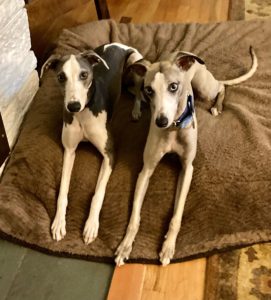Is your dog a good match for Solo Dogs?

My dog Io (on the left) with her buddy Alfie
A successful boarding experience comes from making sure that my dog and boarding environment are a good match for your individual small dog’s personality, health, behavioral issues, exercise requirements, and training. Your dog should be:
- Not reactive or aggressive towards dogs. Before scheduling a meet and greet with my dog, you’ll be asked whether your dog has any history of reactivity towards dogs. My boarding clients do not bark or lunge at other dogs on walks.
- Not aggressive towards humans. If your dog is shy and fearful and requires a “proper introduction” and time to become comfortable around new people, this is totally fine. Your small or senior dog should not growl, snap, or bite at humans without reasonable provocation. If your dog has bitten, growled, or snapped at any of your family members, you dog isn’t a good match.
- No separation anxiety – Your dog should be able to be left unattended for 2 hours in a small room with a baby gate (or crated) without any vocalizations (whining, barking, howling) or attempt to escape, or causing harm to themselves or property.
- No resource guarding – Your dog should not growl or snap if they have water or toys or are laying on a bed if another dog approaches or a human approaches them.
- Perfectly house-trained with no history of marking indoor areas. If your elderly dog has occasional accidents, they will be restricted to a room off my kitchen. Dogs who are fully incontinent, use pee pads, or are unable to control their bladder/bowels to give me time to take them outside, will not be accepted.
- No body handling issues. Family members must be able to safely handle, move and or lift your dog without growling, snapping or biting and intervene during play without your dog redirecting and biting or snapping.
Additional Requirements:
- Between 10 and 30 lbs (senior and special needs dogs who are over 30 lbs will be considered on a case-by-case basis based on temperament, activity level, mobility and past boarding experience.)
- Able to be contained by a 6 ft fence chain link or wood fence.
- Does not dig holes
- Spayed or Neutered (age dependent)
- Does not require medical intervention during the stay (expressing bladder, subcutaneous fluids, dressing changes). Medication that can be dosed as chewable is fine.
- Is not reactive to the sight or sound of school buses (which drive past my yard’s fence and often idle and park there when school is starting or ending).
- IMPORTANT: On a “gluten-free” diet during their stay with me. Gluten-Free means: no wheat, rye, barley, or oats, therefore a “Grain-Free” dog food meets this requirement.
- SUPER DUPER IMPORTANT: Get along well with my dog. She’s the ultimate judge on whether a new dog joins the SoloDogs pack 🙂
Dog Boarding Rates
$95/ per night (min charge, even if just here for a daytime boarding stay)

My dog Io (bottom) looking up lovingly at Baker.
Think We’re a Good Match?
SoloDogs follows a process to thoroughly screen all applicants for boarding, so you are encouraged to begin the application process well in advance of any dates of travel.
Step 1: Fill out my Contact Form and give me info about your dog. Once I’ve received your form I’ll respond and if I think you may be a good match for SoloDogs, I’ll send you a link to my detailed Boarding Application. Please read the requirements before contacting me.
Step 2: Boarding Application
It’s long, but it’s designed to be sure your dog is a good match for my boarding environment and skill set. You’ll get a link after I’ve reviewed your contact form.
Step 3: Meet and Greet:
You’ll bring your dog to my home for a meet and greet. These typically last two hours. First we’ll take a walk together in the neighborhood and if that goes well, we’ll then move into my back yard. Due to Covid we will not be entering my home together.
Step 4: Trial Overnight ($50):
A trial overnight will be conducted during which you’ll provide all the gear necessary to ensure a good night’s rest for your dog, and dinner and breakfast. During the trial overnight an absence will be conducted to make sure your dog doesn’t vocalize or otherwise display signs of separation anxiety and can be easily contained in a room behind a baby gate, expens or while crated.
